Black and orange bugs are common in North America and The Caribbean. These types of bugs can suck plant sap or even eat other bugs.
Found across a few different species, the black and orange color combination can sometimes signal potentially-poisonous bugs. While some of the following bugs can bite or even transmit Chagas disease, they aren’t poisonous.
Table of Contents
1. Large Milkweed Bug
Common in North America, South America, and The Caribbean, this bug (Oncopeltus fasciatus) grows to a maximum size of 12mm.
The species is identified by its black and orange coloring.
Orange coloring forms marks of an X shape on the dorsal. The lower abdomen is black.

The Large Milkweed bug is also the only black and orange species to have a large black band across the X-shaped orange marks on the dorsum.
As its name implies, this species eats Common milkweed seeds.
It also feeds on Caribbean milkweed and nerium flower seeds.
2. Eastern Boxelder Bug

Eastern Boxelder Bugs (Boisea trivittata) are native to the US. Bugs of this genus are identified by their dark color with a colored line.
The species has a dark brown body that almost appears black.
It features a red line on the sides and it grows to a size of up to 12.5mm.
Eastern Boxelder bugs are mostly seen in the summer months. The species prefers to retreat to buildings to overwinter.
Common around boxelder trees, maple, and ash, Eastern Boxelder bugs are also known for living in mixed forests and sometimes outside them in meadows.
3. Small Milkweed Bug

Small Milkweed bugs (Lygaeus kalmii) have an oval-shaped body that’s mostly black. Orange-red diagonal lines can be further distinguished on this oval-flattened body.
These bugs are native to the US but are also found in other parts of the world.
Small Milkweed bugs get their name from their attraction to milkweed. This bug species lays eggs on milkweed.
This bug lays eggs on milkweed.
The species feeds on milkweed as larvae and into adulthood. Small Milkweed bugs eat milkweed nectar.
With small cockroach resembles, Small milkweed bugs may also eat flies and other bugs whenever there’s no milkweed around.
4. Two-lined Spittlebug

Known as a mild pest, Two-lined Spittlebugs (Prosapia bicincta) have a dark, almost black body. This species 2 yellow horizontal lines across the elytra and it measures up to an inch.
Two-lined Spittlebugs are not a major garden pest, but they can still be damaging to plants, flowers, and grass.
Young Two-lined Spittlebugs tend to be the most damaging as they attach themselves to certain plants and continue eating them until becoming adults.
The most likely place to see Two-lined Spittlebugs is on ornamental plants.
The species might also temporarily be seen eating weeds.
5. Harlequin Bug

Growing to a size of up to 9.5mm, Harlequin Bugs (Murgantia histrionica) are mostly known for eating cabbages.
These bugs have a black body with either orange or red marks. They have black legs and black antennae.
Harlequin bugs are known for overwintering as adults in an inactive state.
They emerge early in the spring when they seek out cabbages and cauliflower among other crucifers to feed on.
They drink sap and they continue doing so until the cabbage is dead or not usable.
Insecticides are sometimes used against Harlequin bugs. Hand-picking them might also be an option when their population is low.
6. Milkweed Assassin Bug

Found in North America, Milkweed Assassin bugs (Zelus longipes) have an elongated oval flattened body that grows to 18.5mm.
These bugs are known predators and they have a very wide diet which may make them beneficial in gardens.
Before attracting these bugs to your garden, you need to know Milkweed Assassin bugs can bite. This results in a prolonged burning sensation.
Bugs of this species eat a wide range of bugs including beetles, flies, mosquitoes, and armyworms.
Soft-bodied insects and bugs are consumed by Milkweed Assassin bugs which trap them by ambushing them.
7. False Milkweed Bug

False Milkweed bugs (Lygaeus turcicus) are native to Eastern North America.
These bugs have an oval-shaped flattened body with multiple red stripes.
Bugs of the genus are seen on false sunflowers. They like the seeds of these flowers similar to sunflowers.
False Milkweed bugs are confused with other bugs that are black and orange. Many of these bugs have similar orange lines.
The easiest way to differentiate False Milkweed bugs from other similar species is by their presence on false sunflowers.
8. Western Boxelder Bug

Western Boxelder bugs (Boisea rubrolineata) live on the West Coast. They are very common in California around Los Angeles.
These black and orange bugs have a black body and orange-red lines. It immediately stands out on the boxelder and maple trees it feeds with.
The abdomen of these bugs is orange-red.
Seeds of these trees are often consumed by Western Boxelder. Otherwise, they prefer to eat fruit.
Preferring warm and dry habitats, Western Boxelder bugs can also end up inside the house.
9. California Bordered Plant Bug

California Bordered Plant bugs (Largus californicus) get their name from the orange stripes bordering their body.
These bugs are black and common in Western parts of the US, including California.
The species has sharp mouthparts used to suck the liquid out of plants and flowers.
Some of the most common fruits these bugs can pierce and eat include strawberries. They can consume almost any type of soft fruit they can pierce.
Growing to a size of just over 1 inch, these bugs are easy to identify as they maintain their aspect into adulthood.
Nymph California Bordered Plant bugs have a small black body with an orange-red mark.
10. Orange Assassin Bug

The Orange Assassin bug (Pselliopus barberi) is the most common type of black and orange bug in North America with a dominant orange color.
The orange nuance has yellow-golden undertones creating a richer color.
Part of a wide range of assassin bugs that eat insects and other bugs, the Orange Assassin bug also has orange and black bands on its legs.
These bugs are diurnal and move around looking for prey but also use ambushing catching techniques.
Woodlands, where piles of ground-level leaves abound, are among their favorite habitats.
They retreat under tree bark or trunk crevices to rest at night.
11. Jagged Ambush Bug

Jagged Ambush bugs (Phymata americana) are very good ambush predators. They can sit for hours waiting for insects to come to flower buds.
These bugs have an orange body with black sections.
Color adaptations are specific to this genus as the Jagged Ambush bug can match the color of its host plant.
This helps it improve its chances of remaining undetected and of catching insects faster.
Bees are among the first victims of this killer bug. Bees unknowingly approach flower bugs when the bug moves closer to ambush the,
Female Jagged Ambush bugs are large than males and faster in ambushing movements.
12. Eastern Bordered Plant Bug

Eastern Bordered Plant bugs (Largus succinctus) have a dark brown to black body with orange margins.
The brown coloring of the species also shows small black dots all over the body.
This brown-black combination is seen both on the dorsal and ventral sides of the species.
When it comes to the orange bands, these are of a pure orange color without any yellow or red nuances as in other Bordered plant bugs.
Eastern bordered plant bugs have elongated mouthparts used to suck plant sap.
They mate and lay eggs on plant leaves. These bugs may hide under tree bark or in natural crevices or tree cracks at night.
13. Cactus Coreid

Cactus Coreid (Chelinidea vittiger) is also known as cactus bugs. The species has a dark or black body with yellow and orange borders.
These borders can sometimes be yellow and orange-brown.
Spotting the bug is easy given the colored orange and yellow bands contour its body.
As its name implies, the Cactus Coreid feeds on cacti. The signs of its feeding habits and invasion are immediately visible.
Small yellow spots in the shape of circles are visible on the cactus.
There are so many yellow circle spots on a cactus in case of an invasion that the entire cacti look pale yellow rather than green.
14. Speckled Sharpshooter

The Speckled Sharpshooter (Paraulacizes irrorata) is a bug that has a black color and which looks sprayed with orange paint.
Its elongated body also has an orange-yellow underside.
Bugs of this genus have an elongated body that grows to an average of 12mm. The head is black as are the legs.
There’s a certain shine the bug has.
With a unique look, this bug is always interested either in eating or in laying eggs. Speckled Sharpshooters lay eggs in twigs or stems.
15. Conchuela Bug
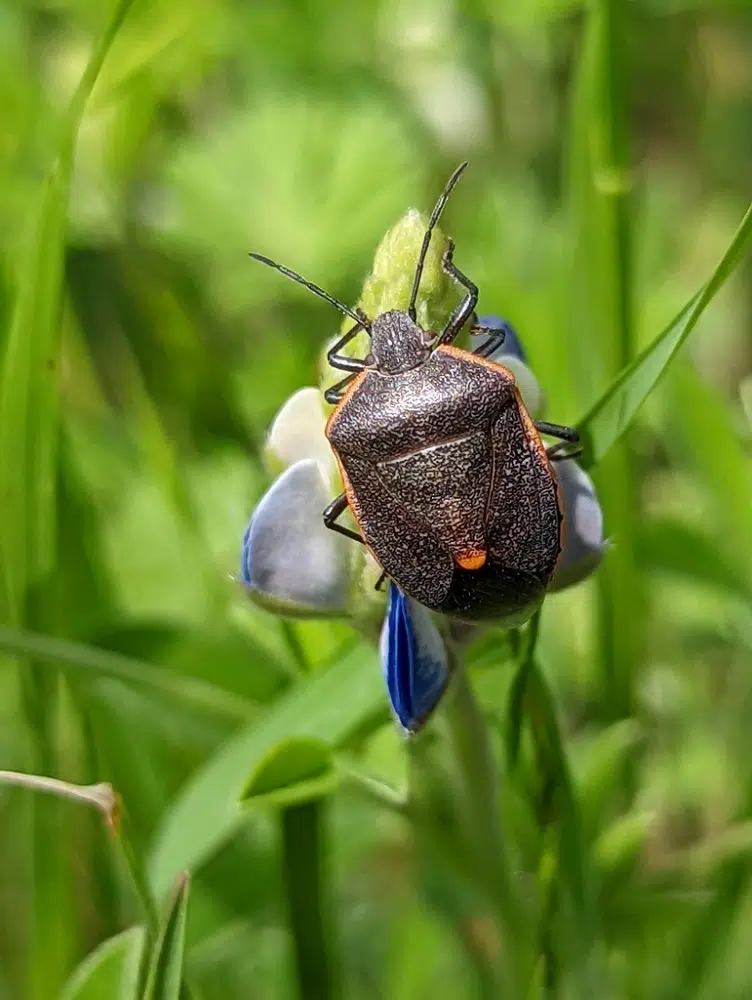
Conchuela bugs (Chlorochroa ligata) emerge in the spring as they overwinter as adults. These bugs are mostly found under leaf litter, rocks, logs, or hiding in crevices during the winter when they aren’t active.
As soon as spring arrives they are ready to move out looking for food.
Bugs of this genus have a brown body with black spots and orange banding around their edges.
Its orange band is vivid orange rather than dull orange. This means the orange band is closer to red than yellow.
The color of these bugs can also vary from black or even green.
Once males and females mate, the female Conchuela bug is ready to lay up to 30 eggs which may hatch as soon as 30 days.
16. Florida Predatory Stink Bug

Florida Predatory Stink bugs (Euthyrhynchus floridanus) have a black color and either orange or red marks and stripes.
Bugs of this species have a shield-like body shape that narrows towards the rear abdomen.
Commonly seen on ornamental plants, this Florida bug can be found around citruses and flowers.
It looks for various prey depending on its life stages.
Larvae of the Florida predatory stink bug eat moths. Adults have a wide diet that also includes other smaller species of stink bugs.
Florida Predatory Stink bugs eat weevil, beetles, and larvae of other bugs such as cutworms.
Once mature, the female Florida Predatory Stink bug can lay up to 140 eggs at once.
17. Ringed Assassin Bug

Ringed Assassin Bugs (Pselliopus cinctus) are known for their predatory behavior.
They eat small bugs, insects, and larvae.
Ringed Assassin bugs have an orange-black color. The oval shape of the body has a brown color while its edges are yellow.
Black bands are visible on the legs. The head is almost completely black.
While a carnivore species, the Ringed Assassin bug can also eat flower nectar.
18. Bagrada Bug
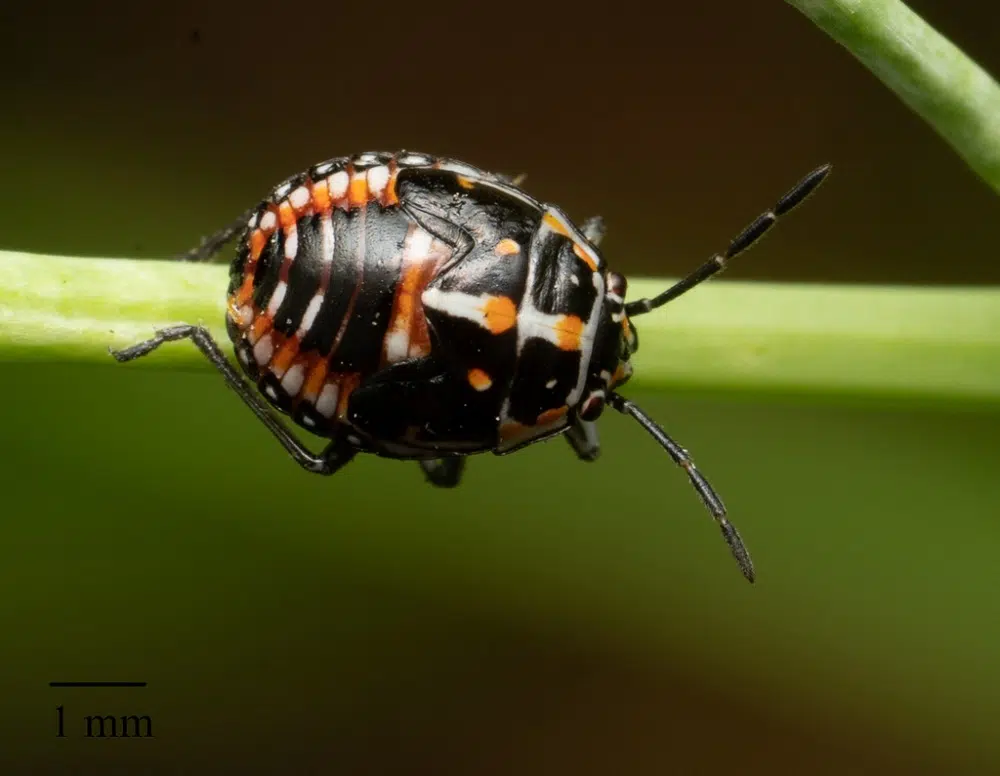
Bagrada bugs (Bagrada hilaris) look similar to Stink bugs at first. They have a similar shape and a similar size.
However, Bagrada bugs have an elongated body both towards the head and towards the abdomen.
These black and orange bugs are common in California where they create problems for farmers and gardeners as pests.
Bagrada bugs have a black body with orange spots that have white margins and a central orange line with white margins.
The species is identified in cruciferous vegetable crops. This includes kale, cabbage, and cauliflower crops which they like to eat.
The bugs eat these vegetables and they turn to weeds whenever there are no more vegetables to eat.
Bagrada bugs are further known as a major pest in the entire Southwestern United States area, not just in California.
19. Corsair Assassin Bug

These bugs (Rasahus hamatus) are known for having a dominantly black color.
They can also have brown or orange legs and marks on the back. Only 2 colored marks are seen on the dorsal of the Corsair Assassin bug. There’s one chevron-like mark on the thorax and one round spot on the abdomen.
The legs of the species are also orange.
These bugs are small predators. With a size of only 7-10mm, they can hide in plants and flowers looking for small insects and larvae to feed on.
Corsair Assassin bugs have a widespread presence around the Americas and in the Caribbean.
20. Mountain Laurel Scarlet Mirid
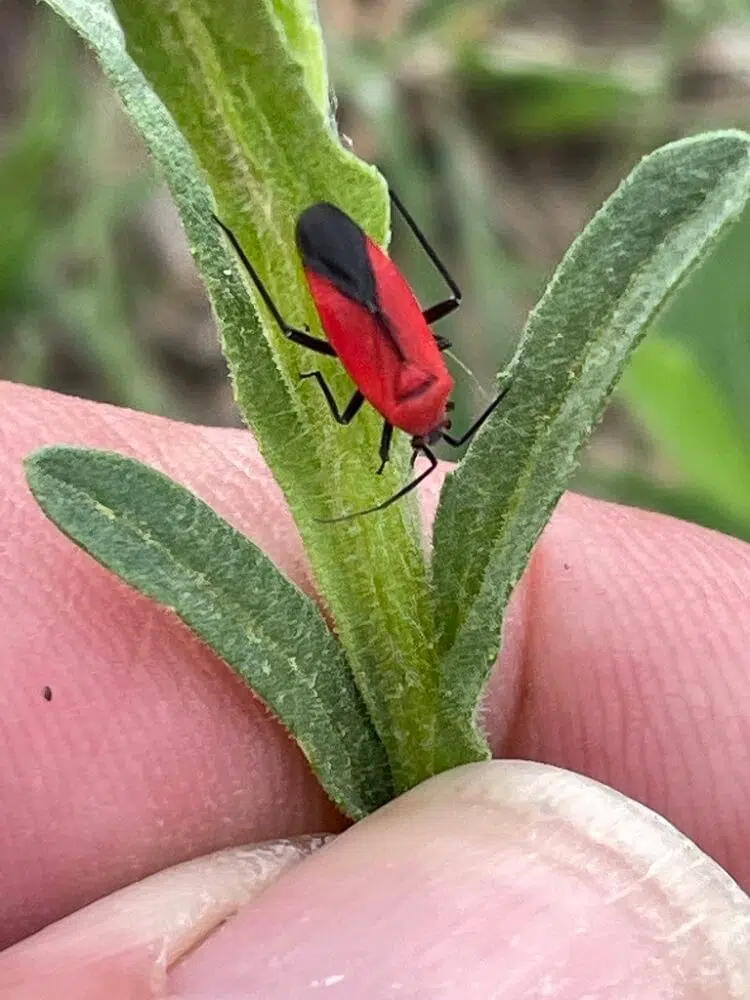
Common in Texas, the Mountain Laurel Scarlet Mirid (Lopidea major) is a black and orange bug that lives on plants.
These elongated bugs measure up to 9mm and they are known to feed on various green leaves.
However, there are no considerable damages caused by the Mountain Laurel Scarlet as this species doesn’t multiply in high numbers.
Bugs of the Mountain Laurel Scarlet Mirid live in all types of warm habitats. It’s one of the common bugs in Texas parks.
21. White-crossed Seed Bug

White-crossed Seed bugs (Neacoryphus bicrucis) have a dominant orange-red color. Small sections of its body are black.
The species also has X-shaped white bands on its body delimiting the orange sections from the black sections.
White-crossed seed bugs are a very common species on groundsels. They might not have a major role in the ecosystem of these plants but they can invade and lay eggs on them.
Bugs of this genus are known to lay eggs on the underside of groundsel leaves.
22. Mediterranean Red Bug

A similar color pattern to White-crossed Seed bugs is seen on the Mediterranean Red bug (Scantius aegyptius).
This species has very common red or orange coloring with black sections on its dorsal and black ventral color.
Its, legs, head, and antennae are also black.
This species grows to a maximum of 10-12mm and can be found across North America.
23. Anchor Stink Bug

The Anchor Stink bug (Stiretrus anchorago) is a known species on cauliflower, cabbages, other crops, and ornamental flowers.
This black stink bug has an orange-red mark on the rear side of its abdomen while the rest of its body remains almost completely black.
Identified by its round flattened body, the Anchor Stink bug is carnivorous. It feeds on the Mexican Bean Beetle as well as on all types of invasive species on soy fields or alfalfa fields.
Anchor Stink bugs don’t have a particular season as they remain active in the areas they are most common in such as in Southern Florida.
24. Metriorrhynchomiris dislocate
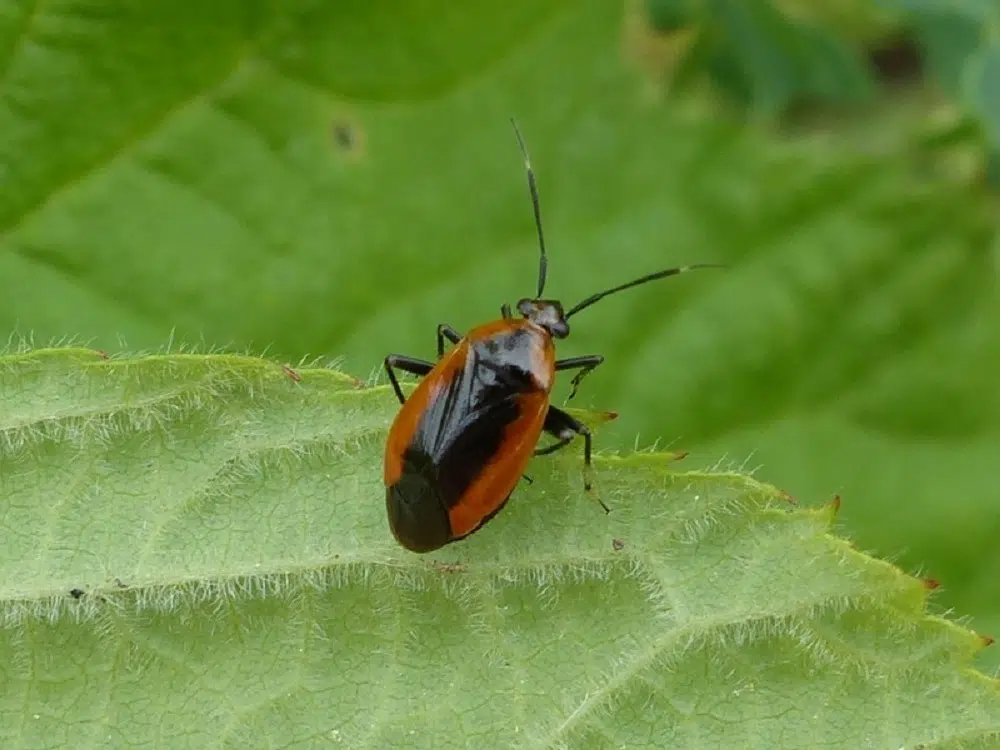
Common in North America, this plant bug species has orange-black or black-orange coloring.
It’s a common species in areas such as crops and flower fields. The female has mostly orange coloring while the male has mostly black coloring.
The bug is known for its orange stripes on the edge of its black body. The colors of this genus can also be inverted so that black stripes are only visible on its orange body.
Some morphs of the species are almost completely black with a mostly orange collar behind the head.
25. Common Cotton Stainer Bug

This species (Dysdercus suturellus) is common from Georgia to Alabama.
It looks different from other species of Stainer bugs as the dorsal is black and the ventral is orange-red.
Bugs of this genus also have colorful orange-red heads.
There’s an X-shaped mark on its dorsal which also makes for easier identification. The white mark is visible on all morphs of this species.
With a name inspired by staining its cotton, the Common Cotton Stainer is a major pest in citrus plantations, particularly in oranges it mimics the color.
26. European Firebug

The European Firebug (Pyrrhocoris apterus) is one of the common black-orange species of Europe and Asia.
This bug is often confused with other common European bugs such as the Common Squash bug.
However, it does not feed on squash. It feeds on lemon tree seeds.
European Firebugs are very common around lemon trees which grow in Southern Europe and Asia.
These bugs might also be imported with lemon or lemon trees.
Identification is easy based on its very colorful dorsal which is either red and black or orange and black.
Irregular stripes are seen all across its dorsal making it one of the species that are easy to spot on tree bark.
The European Firebug needs a lot of sun and it prefers to rest in sunny areas.
The diurnal species is always found on the sunny side of trees.
27. Charcoal Seed Bug

Charcoal Seed bugs (Melacoryphus lateralis) are native to North America.
The species is mostly tied to arid desert habitats and it can appear at any time of the year given the warm weather of its environment.
Charcoal Seed bugs have a dark charcoal color that almost appears black. Its margins are either red or orange.
Bugs of the genus also have small colored spots behind its head.
Charcoal Seed bugs are social creatures. While they don’t build nests, they always live close to each other.
Some data suggests they prefer to live socially to better protect themselves from predators such as birds.
28. Eastern Bloodsucking Conenose

Eastern Bloodsucking Conenose bugs (Triatoma sanguisuga) are some of the most problematic black and orange species when it comes to public health.
This species has a known bloodthirst which is mandatory for it to survive.
Female Eastern Bloodsucking Conenose bugs need a blood meal to lay eggs.
Juveniles also need a blood meal between their molts.
The Eastern Bloodsucking Conenose can be seen both inside the house and outside of the hose.
It can be difficult to spot as it has a nocturnal nature.
Eastern Bloodsucking Conenose bugs hide behind furniture or in secluded areas of the house.
In their natural habitat, they prefer to hide under leaves and fallen branches.
These bugs bite for blood. They can sometimes bite people.
Bugs of the genus also bite various animals such as rats and raccoons.
One of the areas they find these mammals is in their nests. As a result, Eastern Bloodsucking Conenose bugs are often found in the nest of various mammals.
29. Red Bull Assassin Bug

Red Bull Assassin bugs (Repipta taurus) grow to a maximum size of 11 to 13mm.
This predatory species has ambushing techniques and it can be identified by its colorful body.
Similar to other assassin bugs, the Red Bull Assassin bug has black legs and a colorful body.
Both its dorsal and ventral sides have orange coloring.
The ventral side is dominated by orange colors with black stripes.
The bug is mostly known for its black-dominant dorsal with orange stripes on the edges and an orange head with small black eyes.
This bug can often be found on orange flower buds awaiting its next meal.
30. Bee Assassin

While it eats bees, the Bee Assassin (Apiomerus crassipes) is both a beneficial and a detrimental species to the ecosystem.
One of the reasons it’s considered a pest is for its bee-eating habits. This bug can eat a wide range of bees essentially killing natural pollinators in North America.
However, not all bees eaten by the Bee Assassin are very good pollinators.
Its beneficial role is seen when it eats ants. Bee Assassins even eat flying ants.
These bugs have a black color with orange margins. They sit on flower buds where bees come to collect pollen.
They also move on flowers for ants which follow various bugs and butterflies for their honeydew-making role.
31. Meadow Plant Bug

The Meadow Plant bug (Leptopterna dolabrata) is one of the most common species of black and orange-brown bugs.
As its name implies, the Meadow Plant bug is high common on grassy fields, meadows, and prairies.
This bug is mostly found in Europe.
Meadow Plant bugs have also been introduced to North America where they are mostly known for their negative impact on your grass.
32. Scarlet-bordered Assassin Bug

The Scarlet-bordered Assassin bug (Rhiginia cruciata) is almost completely black. It has a black body with orange-red margins
Its head and legs also have orange and black colors.
Regardless of its orange nuances, this bug cannot be seen during the day as it prefers to hide away under rocks, logs, or leaves as a nocturnal species.
The bug is known to feed on other bugs and insects including caterpillars.
Growing to a size of up to 16mm, the bug can be identified by its elongated body with an oval shape that’s wider at the abdomen and narrower towards the thorax and the head.
Bugs of this genus have a tan underbelly and they move on ground level or plants looking for food.
33. Mexican Bordered Plant Bug

Like all bordered bugs, the Mexican Bordered Plant bug (Largus maculatus) has a bright color band around its body.
This band can be orange, red, rusty, or brown.
The bugs come in different colors and they are mostly described as having a tan to brown dorsal with black and orange marks and bands along the body.
The species has black legs and it’s known to eat various green plants.
Mexican Bordered Plant bugs are found in Southern US regions throughout the year.
34. Decula 17-Year Cicada

This orange and black bug (Magicicada septendecula) lives such a long life that its longevity inspires its name. Many bugs of this species live for 17 years.
The bug has atypical coloring and an atypical shape as its wings are orange but transparent and considerably longer than its body.
Its head and abdomen are black while its eyes are orange.
The legs of this bug are a combination of black and orange.
Bugs of this genus can fly and they feed on various plants and plant leaves.
35. Two-spotted Stink Bug
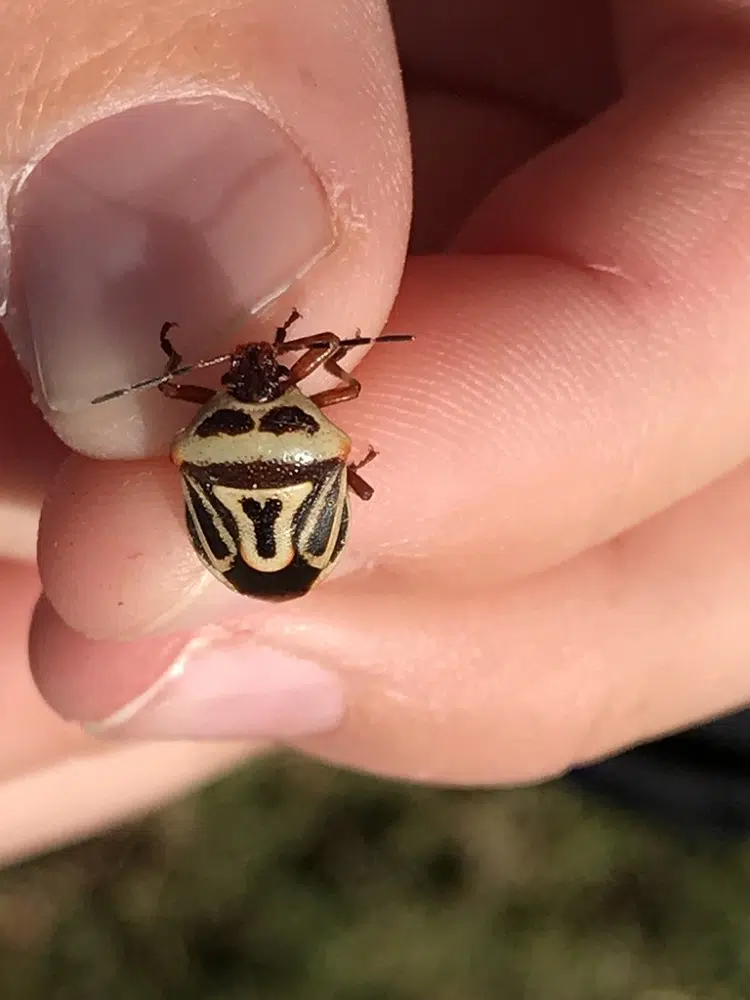
The Two-spotted Stink bug (Perillus bioculatus) is a common species in the US and a native species in North America.
It gets its name from the colors of its dorsal.
The main color of its dorsal is black. Red lines and shapes are common on its body.
This bug has a distinct keyhole shape on its bad. It also has 2 black spots just behind its head.
These 2 characteristics make it a species that’s not easily confused.
Like all stink bugs, it has a bad taste and it can often make animals that try to eat it regurgitate.
This species is known to eat all types of small pest bugs which might make it a beneficial species in gardens and on crops.
36. Eastern Regal Oak Mirid

The Eastern Regal oak Mirid (Pseudoxenetus regalis) is a common species in the US states on the Eastern Coast.
Bugs of this genus have a very elongated body, often compared to a stick. Its coloring is a combination of red-orange with black.
The part behind its head is orange while the rest of its body is black.
The legs of the Eastern Regal Oak Mirid are orange and black.
Bugs of this genus look exactly like most other Mirid bugs. All of them have an elongated body and all of them feed on plants and leaves.
The Eastern Regal Oak Mirid lives in oak forests and it can be found on the ground, among leaves.
37. Hedgenettle Stink Bug
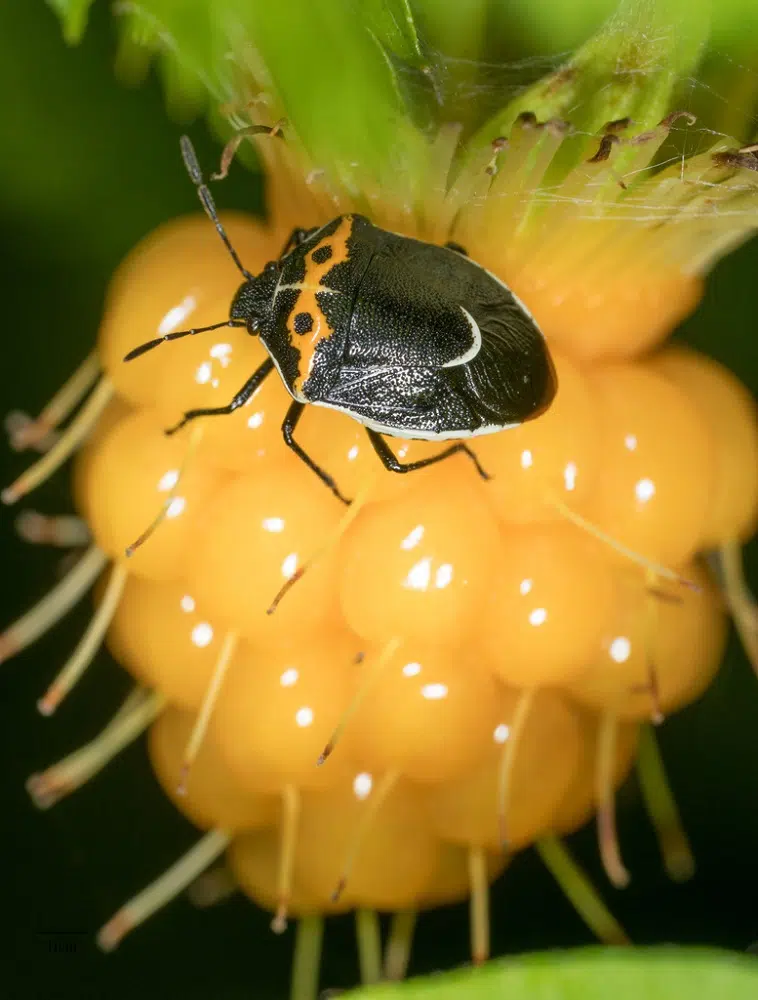
The Hedgenettle Stink bug (Cosmopepla conspicillaris) is known for feeding on the plant with the same name. Also known as the Happy Bespeckled Stink bug, this species has orange markings similar to a smiling face.
Its black body dominates its appearance. By contrast, this species has a few orange marks that make it stand out.
Hedgenettle Stink bugs have a dark color which is always black or dark blue.
There’s a singular chevron-style orange marking on the abdomen and an orange mark with 2 black spots resembling speckles behind its head.
The margins of its body show thin orange lines.
Bugs of this genus are found on plants of the Stachis genus and this helps differentiation from other dark color stink bugs with speckles-like markings.
The orange color is also unique for these types of markings.
Bugs of this genus grow up to an inch and they have the shield-like shape specific to these bad-tasting bugs.
38. Six-spotted Milkweed Bug

6 orange spots on the dorsum of this bug (Oncopeltus sexmaculatus) give its name.
The Six-spotted Milkweed bug is one of the longest black and orange bugs in North America.
Bugs of this genus have a contrasting-color body. They are among the species most likely to be seen on various flowers with colorful adaptations to the flowers they visit.
This is why orange-spots Six-spotted Milkweed bugs are found on Butterfly weed and other orange flowers.
Multiple other color variations of this species include a yellow and a red morph.
All of these morphs have 6 colorful spots on a black dorsum.
The legs and antennae of the bug are all-black except the head which has a bright red mark.
39. Western Corsair Bug

Western Corsair Bugs (Rasahus thoracicus) are one of the common black and orange species of the Northwest.
This bug grows to a size of 23mm and it stands out with a contrasting black and orange coloring.
Its dorsum is black with a large round orange spot and a chevron-shaped spot behind the head.
The margins of this bug are also partially orange. Its head and legs are also orange.
Western Corsair bugs are carnivores. They eat a large range of small bugs and their larvae as well as eggs of multiple other insects.
Aggressiveness is one of the essential characteristics of this species. Western Corsair bugs bite and this leads to a painful reaction.
However, the bug doesn’t carry bacteria or disease-causing viruses.
40. Neocapsus cuneatus
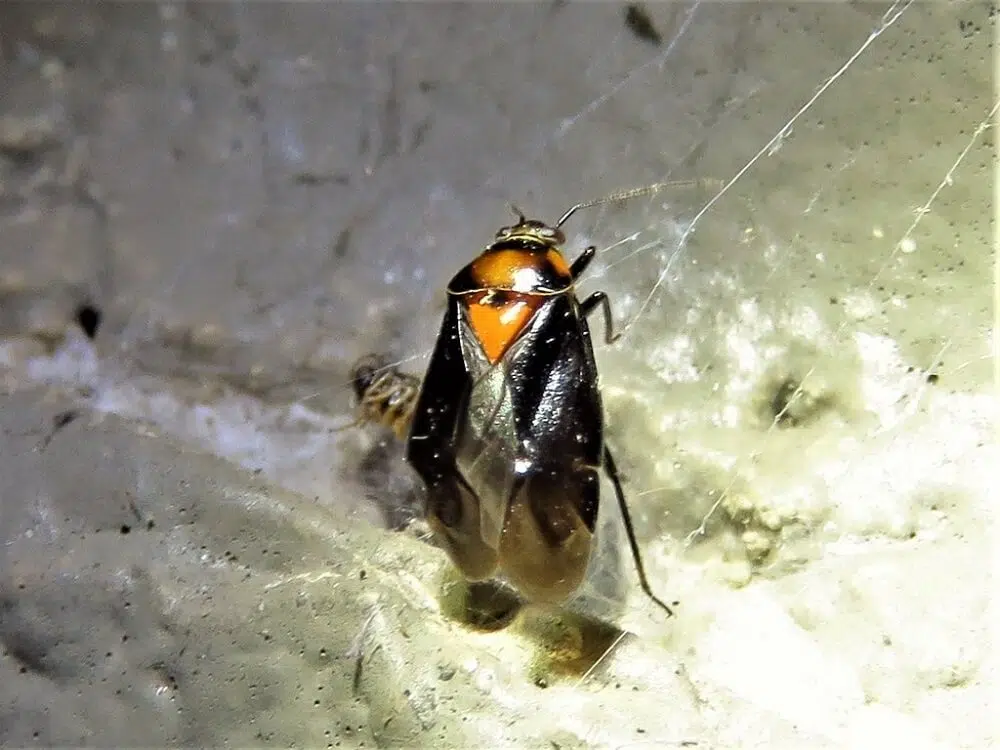
This black and partially orange bug resemble the American cockroach in its shape but it doesn’t get inside the house.
This bug is not a pest as it mainly feeds on grasses, leaves, and plant stems.
It grows to a maximum size of 10-12mm and it can be identified by its black body with 3 pairs of legs.
The orange coloring is present in the form of a band just behind its head.
These bugs also exhibit orange colors further down on the dorsum but these colors darken to a black color as the bug ages.
41. Rhynocoris ventralis
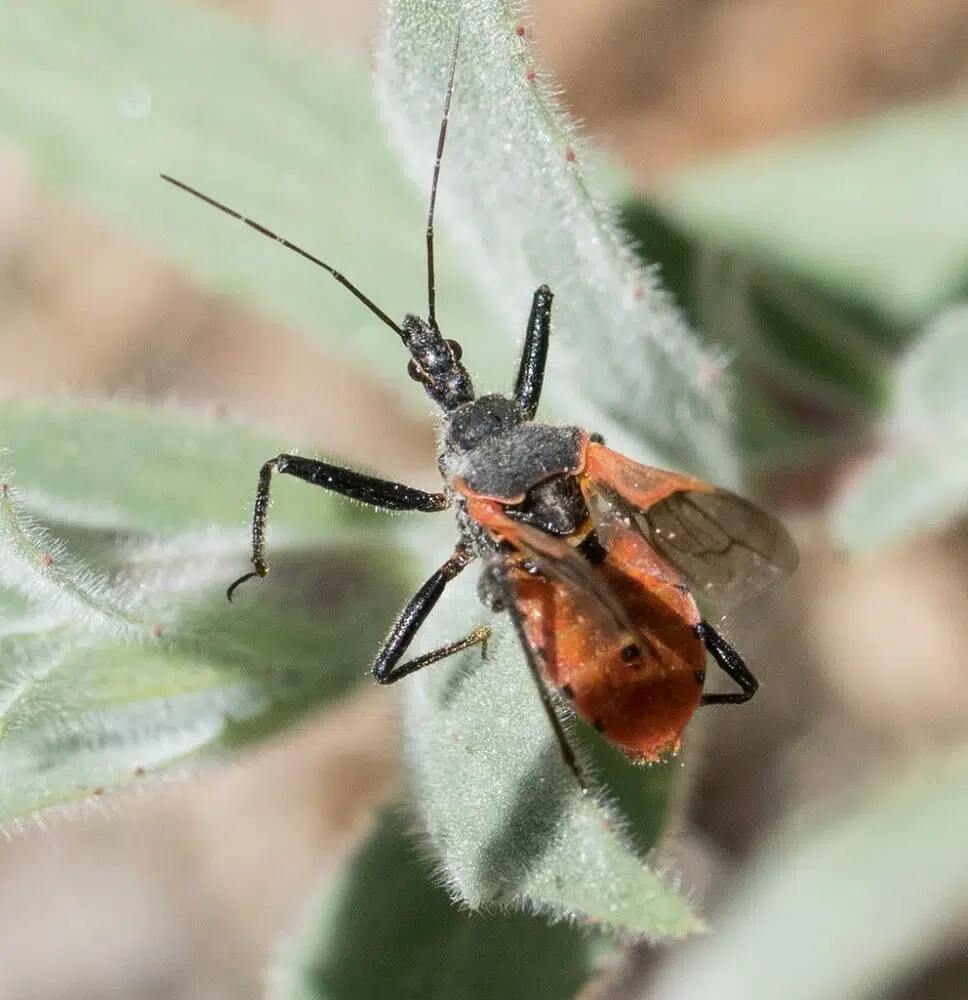
This terrestrial orange and black bug is an assassin bug. It uses ambushing techniques against small insects and larvae and it can also bite.
Buts of this genus are primarily orange as half of their bodies and their legs are orange.
The central portion of the dorsal is black, as is the head. The margins and the lower abdomen are orange or orange-brown.
The legs are also orange with only 2 black bands.
Tiny black spots are also seen on the edges of this bug, contrasting its vivid orange color.
The species is terrestrial and often hiding under fallen leaves or vegetation and is difficult for prey to spot.
42. Oncometopia hamiltoni
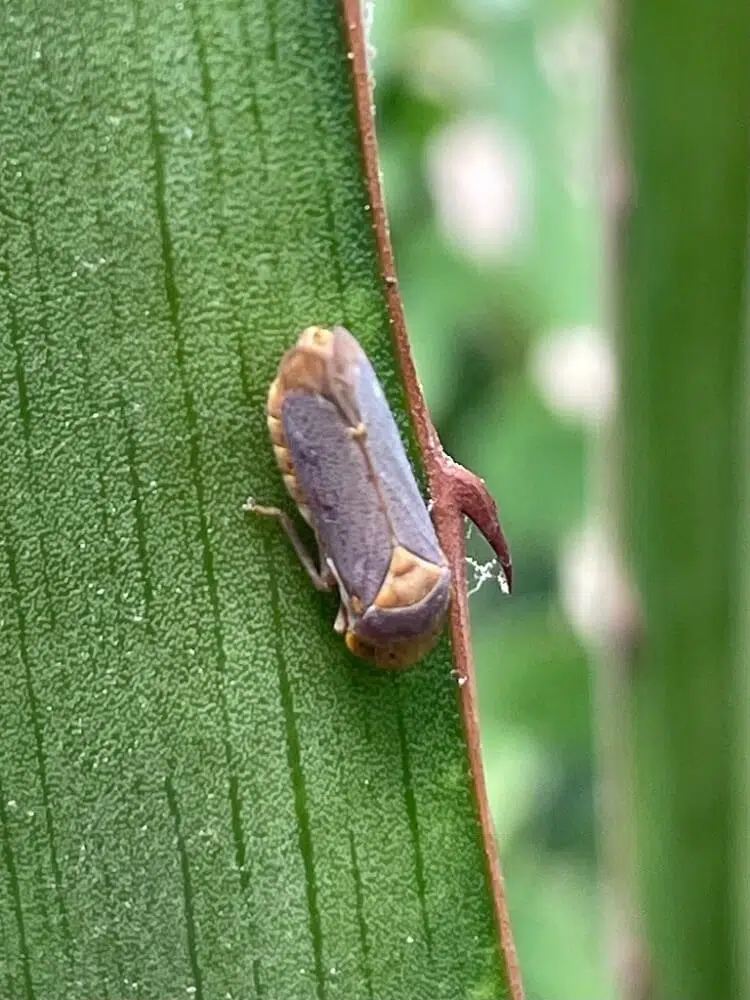
These bug species are found in Southern Texas and Mexico.
It feeds on plant leaves and it has a tricolored body that isn’t green so the bug stands out on vegetation.
This species has an orange ventral color and an orange head. Its head is considerably wider than its body.
The dorsum of the species is partially black with light blue spots from the head to the tip of the abdomen.
Growing to a size of 11.4mm, this bug can jump from one leaf to another.
Feeding is based on consuming sufficient plant juice. The bug has piercing mouthparts used on plant leaves.
43. Southern Small Milkweed Bug

The Southern Small Milkweed bug (Lygaeus reclivatus) resembles the Six-spotted Milkweed bug but it has a different diet.
This is one of the few black and orange bugs that can turn from eating plants to eating insects in a matter of days, in the absence of sufficient food.
The Southern Small Milkweed bug feeds on milkweed seeds. It sucks the nectar out of these seeds.
The bug only likes to feed on these seeds and may not consider other sources of nectar.
In the absence of these seeds, the Southern Small Milkweed bug can even start eating other bugs and insects.
You can identify the species of milkweed through its black body with wide orange stripes.
This species grows to 12mm and it’s as large as some of the largest common black and orange bugs in North America.
44. Blood-colored Milkweed Bug
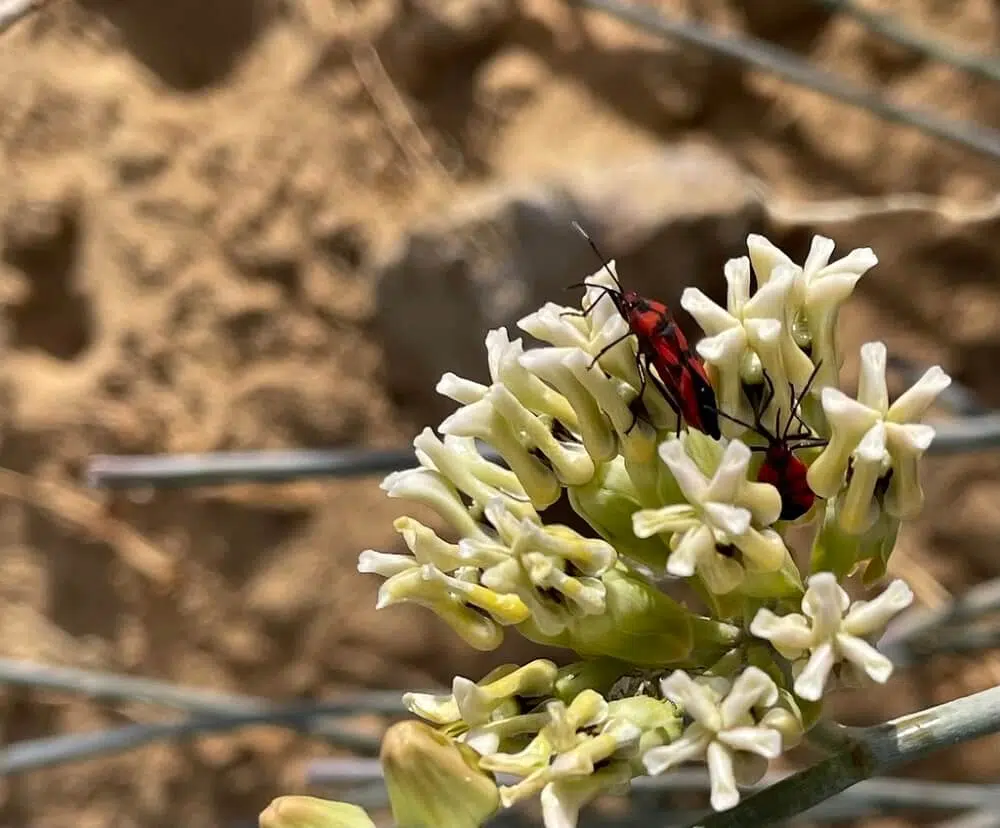
The Blood-colored Milkweed bug (Oncopeltus sanguineolentus) gets its name from its orange-red color which dominates the body of adults and nymphs.
Blood-colored Milkweed is a native North American species common in deserts in southern states.
This bug is always seen around Desert Milkweed which it feeds on.
The species has a dorsal dominated by its vivid blood-orange color with just a few black marks and a larger black spot on the top of the abdomen.
Its legs are also black.
The bug can be seen in Arizona, California, and Nevada and it’s known to only live in areas with sufficient milkweed.
45. Redcoat Seed Bug

The Redcoat Seed bug (Melanopleurus belfragei) is a common species in North America with up to 9 known sub-species.
This bug has an orange- color with black patches that make it stand out on flower buds and flower seeds it feeds on.
The orange sections on its dorsal split in 2, with one orange patch on each side of the dorsum. Similarly-sized black patches are seen on the upper cephalothorax and the abdomen.
The bug is known to have a very vivid color which helps keep predators away.
Redcoat Seed bugs also have other defensive techniques. They release a foul smell when handled or when facing a potential predator.
46. St. Andrew’s Cotton Stainer

Named after the Scottish flag of St. Andrew, this bug (Dysdercus andreae) is native to North America and the Caribbean.
It has a unique color pattern but locals don’t like the bug because it stains fruit.
This bug leaves a color residue on the fruits it feeds and visits.
The species is one of the most important pests in cotton as it can hinder the growth of cotton.
It can be identified by its vivid orange-red dorsum color with a black X-shaped mark that has white borders.
The lower abdomen of the species is black.
Bugs of this genus feed on a wide range of plants and vegetables being seen as a major pest and a common presence in areas with plenty of fruit trees.
It can be removed by hand in small orchard invasions or with insecticides on larger crops.
47. Giant Milkweed Bug
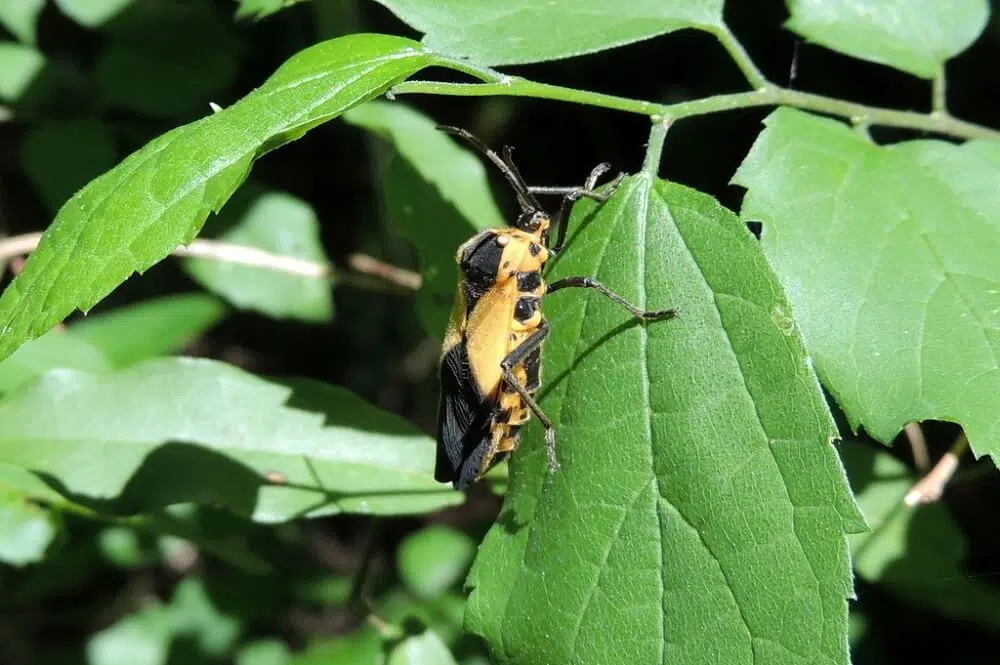
Giant Milkweed bugs (Sephina gundlachii) have a distribution similar to St. Andrew’s Cotton Stainer bugs.
Both are present in North America and the Caribbean. Bugs of this genus are known for sucking plant sap.
Tied to milkweed plants, the species is known for being common in states such as Florida.
This bug is identified by its orange dorsum body.
It has dominantly-orange dorsal coloring with orange margins.
The bug also has black marks on the dorsum and the lower abdomen. This bug shows small black spots on the sides.
These spotted coloring of the bug makes some predators think the species is poisonous.
Further Reading: